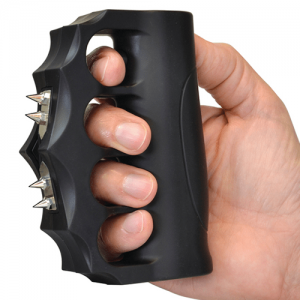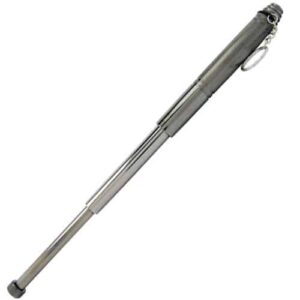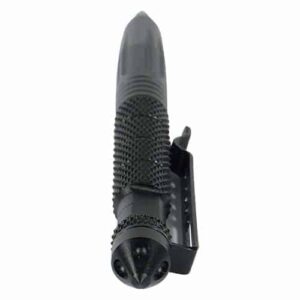Imagine finding yourself in a situation where you feel threatened or unsafe, and you need a way to protect yourself. That’s where the controversy over the civilian use of Tasers comes into play. These devices, initially designed for law enforcement, have become increasingly popular among civilians as a self-defense mechanism. However, this growing trend has raised concerns and sparked debates about the potential risks and consequences of arming non-professionals with such powerful electroshock weapons. In this article, we will explore both the arguments supporting and opposing the civilian use of Tasers, shedding light on a contentious topic that has divided opinions and ignited passionate discussions.
Table of Contents
ToggleOverview of Tasers
What are Tasers?
Tasers are electroshock weapons that are designed to incapacitate targets by delivering an electric shock. They are commonly used by law enforcement agencies as a non-lethal alternative to firearms. Tasers have gained popularity due to their effectiveness in subduing individuals without causing serious injury or death.
How do they work?
Tasers operate by delivering a powerful electrical charge through two probes that are fired when the weapon is discharged. These probes attach to the target’s clothing or skin, creating a circuit and causing temporary neuromuscular incapacitation. The shock interrupts the target’s control over their muscles, rendering them unable to resist or flee.
Effects of Tasers on the human body
When a Taser is deployed, it triggers strong muscle contractions, overwhelming the target’s voluntary muscle control. This results in a temporary loss of coordination, making it difficult for the person to move or escape. Additionally, the electric shock causes intense pain and can also lead to temporary confusion and disorientation.
The Rise of Civilian Use
Increase in availability
In recent years, the availability of Tasers to the general public has significantly increased. They are now easily accessible for purchase through various channels, including online marketplaces and specialty stores. This ease of access has contributed to a rise in civilian ownership and use of Tasers.
Perceived benefits for personal safety
Many individuals choose to own Tasers for their perceived benefits in enhancing personal safety. Tasers are often marketed as an effective tool for self-defense, allowing individuals to protect themselves in potentially dangerous situations. The non-lethal nature of Tasers further adds to their appeal, as they offer a means of protection without the fear of causing fatal harm.
Legal regulations surrounding civilian use
The regulations regarding civilian ownership and use of Tasers vary across jurisdictions. In some areas, Tasers are freely available for purchase and possess no significant barriers to ownership. However, other regions impose restrictions, such as requiring permits, background checks, or even outright bans on civilian ownership. These regulations aim to strike a balance between personal safety and public security.
Controversial Incidents
Cases of excessive force
Tasers have been involved in numerous cases of alleged excessive force by both law enforcement officers and civilians. Instances where Tasers have been used in situations where less forceful alternatives could have been employed have drawn criticism. These incidents have sparked debates on the appropriate use of Tasers and the need for stricter guidelines and training.
Injuries and fatalities associated with civilian use of Tasers
While Tasers are considered non-lethal weapons, there have been instances where their use has resulted in severe injuries and even fatalities. The physiological effects of a Taser shock can be unpredictable, and certain individuals may be more vulnerable to its impacts. These incidents have raised concerns about the potential risks of civilian Taser use and the need for greater awareness of their potential dangers.
Criticism from human rights organizations
Human rights organizations have expressed concerns regarding the use of Tasers, both by law enforcement and civilians. Some organizations argue that Tasers can be easily misused and lead to unnecessary harm, particularly when used on vulnerable populations. They advocate for stricter regulations, improved training, and increased oversight to prevent abuses and safeguard human rights.
Support for Civilian Use
Arguments for self-defense purposes
Proponents of civilian Taser ownership argue that they serve as an effective means of self-defense in situations where individuals may feel threatened. They believe that Tasers provide an alternative to lethal force while still allowing people to protect themselves and their loved ones. Advocates highlight numerous instances where the use of Tasers has successfully deterred potential attackers without causing serious harm.
Positive impact on crime prevention
Advocates of civilian Taser ownership contend that the presence of these devices can act as a deterrent to potential criminals. The knowledge that a potential victim may be armed with a Taser can discourage would-be attackers, making communities safer by reducing the occurrence of crimes. They argue that the availability of Tasers empowers individuals to take responsibility for their own safety, thereby contributing to the overall well-being of society.
Effectiveness in non-lethal force
One of the main arguments in favor of civilian Taser use is their effectiveness in incapacitating a target without causing permanent harm. Tasers have been shown to be highly effective in temporarily immobilizing individuals, allowing for timely intervention by law enforcement or escape from a dangerous situation. Proponents assert that Tasers are a critical tool in achieving a balance between personal security and minimizing potential harm.
Concerns and Potential Risks
Misuse and abuse by civilians
One of the primary concerns surrounding civilian ownership of Tasers is the potential for misuse and abuse. Inexperienced or irresponsible individuals may misuse Tasers as a means of intimidation, leading to unnecessary harm or escalation of violence. It is vital that individuals who choose to own Tasers understand their proper use and the legal and ethical implications associated with their deployment.
Potential for escalation and abuse of power
Tasers, when used inappropriately or without proper judgment, have the potential to escalate a situation rather than de-escalate it. This is especially true when wielded by individuals who lack proper training or may have a tendency to abuse their power. The misuse of Tasers can undermine trust in their use and generate negative perceptions of civilian owners’ responsibility and intelligence.
Lack of proper training and certification
One major criticism of civilian Taser ownership is the lack of consistent and comprehensive training requirements. Unlike law enforcement officers, civilians typically do not undergo rigorous training programs to become proficient in Taser use. This lack of training may result in situations where Tasers are deployed without a full understanding of their potential consequences, increasing the risk of harm to both the target and the user.
Regulatory Measures and Guidelines
Current laws and regulations regarding civilian ownership and use
The legislation surrounding civilian ownership of Tasers varies widely across jurisdictions. Some regions have implemented strict guidelines, requiring individuals to undergo training, obtain permits, or pass background checks. Others have fewer restrictions, allowing for easier access to Tasers. Striking a balance between personal safety and public safety remains a critical consideration in developing and refining these regulations.
Training requirements for civilians
To ensure responsible ownership and use of Tasers, many argue for the implementation of training programs specifically designed for civilians. These programs would cover various aspects, including Taser safety, deployment techniques, legal and ethical considerations, and proper handling. Consistent and widespread training would promote responsible usage, minimize misuse, and mitigate the potential risks associated with Taser ownership.
Proposed changes and improvements to regulations
In response to the concerns surrounding civilian Taser ownership, there have been calls for changes and improvements to existing regulations. These proposals include stricter background checks, mandatory training, and increased oversight to prevent misuse. Additionally, some suggest that access to Tasers should be restricted only to individuals who can demonstrate a legitimate need or a clear understanding of their proper use.
Calls for Banning Civilian Ownership
Advocacy for prohibiting civilian ownership of Tasers
Some individuals and organizations argue for the complete prohibition of civilian Taser ownership, contending that their potential risks outweigh any perceived benefits. They assert that the use of Tasers should be limited exclusively to trained law enforcement personnel, who are subject to stricter protocols and accountability measures. Banning civilian ownership aims to minimize misuse, accidental harm, and the potential for unnecessary escalation.
Comparison with other restricted weapons
Proponents of banning civilian Taser ownership often point to the regulation of other restricted weapons, such as firearms, as a justification for their stance. They argue that if firearms require strict controls to ensure public safety, Tasers should be subject to similar regulations or even stricter measures due to their potential for misuse and harm. Supporters of this view believe that civilian access to Tasers poses an unnecessary risk to society.
Controversy over second amendment rights
The issue of civilian Taser ownership has also sparked debates over second amendment rights, particularly in countries where the right to bear arms is constitutionally protected. Some individuals argue that restricting civilian access to Tasers infringes upon their right to self-defense and personal security. Balancing these constitutional rights with public safety concerns continues to drive the ongoing discussion surrounding civilian Taser ownership.
International Perspectives
Differences in regulations among countries
Regulations surrounding civilian Taser ownership vary significantly among different countries. Some nations impose stringent restrictions and only permit law enforcement officials to possess Tasers. Others have more permissive policies, allowing civilians to own and use Tasers with varying degrees of oversight. Comparing these international perspectives provides valuable insights into the diverse approaches taken in addressing the civilian use of Tasers.
Successful models of civilian Taser use
Several countries have implemented successful models of regulating civilian Taser ownership and use. These models often incorporate comprehensive training and certification programs to ensure responsible ownership and deployment. By examining the experiences of these countries, policymakers can learn valuable lessons and adapt best practices to develop more effective regulations that balance personal safety and public welfare.
International organizations’ viewpoints
International organizations, such as Amnesty International and Human Rights Watch, have been active in advocating for human rights and monitoring the use of Tasers across jurisdictions. These organizations highlight cases of abuse and misuse, calling for stricter regulations and increased accountability. Their perspectives and reports play a crucial role in shaping discussions around civilian Taser ownership and encouraging a global dialogue on best practices.
Alternatives to Civilian Tasers
Less-lethal alternatives for self-defense
For individuals who are concerned about the potential risks associated with Tasers, there are alternative less-lethal options available for self-defense. These include pepper spray, personal alarms, and stun guns, among others. While these alternatives may not have the same range or efficacy as Tasers, they offer viable options to individuals seeking non-lethal means of protection.
Current non-Taser options available to civilians
Beyond alternative less-lethal options, individuals have access to a range of self-defense tools and techniques. Martial arts training, personal safety courses, and situational awareness practices are examples of empowering individuals with the skills and mindset necessary to protect themselves. Exploring and utilizing these options can provide individuals with a comprehensive toolkit for personal safety.
Effectiveness and limitations of alternatives
While there are alternatives to Tasers, it is crucial to recognize the effectiveness and limitations of each option. Pepper spray, for example, requires close proximity to the attacker and may be less effective in windy or confined spaces. Stun guns, on the other hand, may require direct contact and can potentially cause more significant injury. Understanding these limitations helps individuals make informed decisions regarding their personal safety needs.
Conclusion and Future Outlook
Balancing personal safety and potential risks
The civilian use of Tasers remains a contentious topic, with passionate arguments on both sides. Striking a balance between personal safety and potential risks requires careful consideration of various factors, including regulations, training, and the responsible use of Tasers. This delicate balance acknowledges the need for self-defense while ensuring the safeguarding of human rights and minimizing the potential for misuse and harm.
Continued debate and research on civilian Taser use
Given the ongoing controversies and concerns surrounding civilian Taser ownership, it is vital to continue the debate and research. This includes evaluating the effectiveness of current regulations, exploring trends in Taser use and misuse, and studying factors that contribute to the escalation or de-escalation of situations involving Tasers. Engaging in constructive discussions and evidence-based research will enable policymakers to make informed decisions on the future of civilian Taser use.
Potential future developments and improvements
The future of civilian Taser use holds potential for developments and improvements in multiple areas. Advancements in technology may lead to the creation of safer, more effective Taser models that minimize potential risks. Furthermore, continued research can contribute to refining regulations and training programs to maximize the responsible use of Tasers. Capitalizing on these opportunities can help shape a future where personal safety and public welfare harmoniously coexist.













